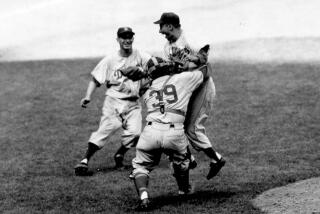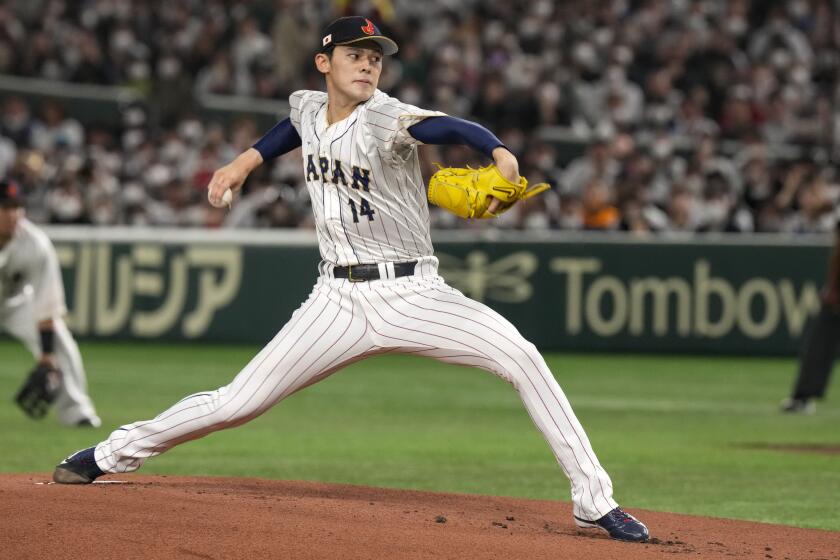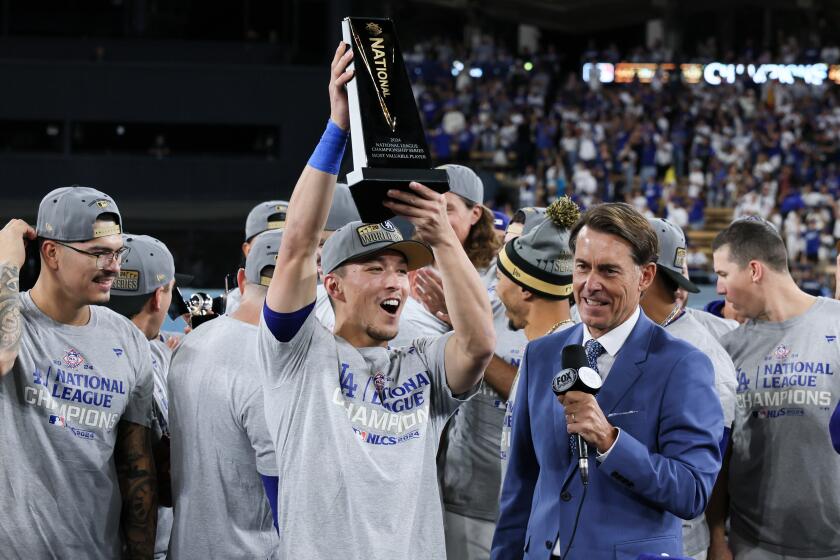Dodgers Dugout: Who are the three best center fielders in team history? (and 3 best left fielders results)
Hi, and welcome to another edition of Dodgers Dugout. My name is Houston Mitchell and it’s time to continue selecting the all-time 40-man roster for the Dodgers.
The all-time team, center field
Before we get to center field, let’s again lay down the ground rules on who is eligible for the polls.
First, we are counting only what they did as a Dodger. Frank Robinson is one of the greatest players of all time, but he played only one season with the Dodgers, so he won’t be appearing here.
Second, position players had to play at least 500 games with the Dodgers, or have had such an iconic moment or season with the team that it wouldn’t make sense to leave them off. (It’s the Kirk Gibson rule.)
Third, only games played since 1901 count. My apologies to those who played before then.
Fourth, players who competed at multiple positions will be listed at the position where they played the most games for the Dodgers. For example, Jim Gilliam played multiple positions for the Dodgers, but he played the most games at second base, so he was listed there.
Finally, you can vote for three players at each position. There will be a link to a site where you can make your selections at the end of each player list. With that, let’s get to it. There are 11 center fielders who meet the criteria for the Dodgers.
Let’s look at them using three stats: OPS+ (on-base percentage plus slugging percentage, which compares them to the league-average hitter each season, making it easier for us to do cross-era comparisons; a league-average hitter will have an OPS+ of 100), WAR (wins above placement, which shows career value) and defensive WAR (which gives a general idea of how well they fielded). Those three stats don’t give a complete picture, but it should give you an overall sense of the value of each player. I encourage you to do further research on each player if you are unsure about them.
OPS+
Duke Snider, 142
Pete Reiser, 132
Matt Kemp, 127
Rick Monday, 121
Johnny Frederick, 117
Joc Pederson, 115
Brett Butler, 112
Willie Davis, 107
Ken Landreaux, 98
Hi Myers, 98
Derrel Thomas, 90
WAR
Duke Snider, 65.7
Willie Davis, 54.6
Matt Kemp, 22.8
Pete Reiser, 19.7
Johnny Frederick, 15.4
Brett Butler, 15.0
Hi Myers, 8.8
Ken Landreaux, 8.5
Joc Pederson, 7.5
Rick Monday, 6.1
Derrel Thomas, 3.9
Defensive WAR
Willie Davis, 12.0
Pete Reiser, 0.3
Derrel Thomas, 0.2
Joc Pederson, -1.2
Johnny Frederick, -2.4
Ken Landreaux, -2.4
Duke Snider, -3.8
Hi Myers, -4.1
Rick Monday, -4.3
Brett Butler, -4.9
Matt Kemp, -9.9
A closer look at the players (statistics are with Dodgers only):
Brett Butler (1991-97, .298/.392/.368): Butler was a pest. He seemed to be on base all the time, ran the bases with reckless abandon and scored 80-100 runs every season. Signed as a free agent, Butler made the All-Star team in his first season with the Dodgers and led the league with 112 runs and 108 walks. His on-base percentage topped .400 three times with L.A. and he played solid defense. He was caught stealing a little too often (28 times in 1991 compared to 38 stolen bases), but he’s the type of player you don’t see too often in the game today. In May of 1996, Butler was diagnosed with cancer of the tonsils. He underwent treatment and returned to the lineup in September. He played one more season with the team and retired.
Willie Davis (1960-73, .279/.312/.413): Davis was an outstanding defensive player who led the NL in triples twice (1962 with 10 and 1970 with 16) and whose offensive numbers don’t look as impressive as they should because he played during one of the biggest pitcher’s eras in baseball history. His best season was probably 1969, when he hit .311 with 23 doubles, eight triples and 11 homers, or it could have been 1962, when he hit .285 with 18 doubles, 10 triples and 21 homers, or 1971, when he hit .309 with 33 doubles, 10 triples and 10 homers. He didn’t walk much and had moderate power, but he caught everything hit to him (except for that one game in the 1966 World Series, but let’s not get into that). He is still the L.A. Dodgers career leader in runs (1,004), hits (2,091) and triples (110). He was traded to the Montreal Expos after the 1973 season for reliever Mike Marshall and retired after the 1979 season. Davis died in Burbank on March 9, 2010.
Johnny Frederick (1929-34, .308/.357/.477): There’s not a lot out there about Frederick. Luckily, baseball historian Graham Womack (you can follow him on Twitter here) has done some great research on him that he has allowed me to use as a basis for this recap. Frederick came into the league as a 27-year-old rookie in 1929 and led the league with 52 doubles (to go with 24 homers). He followed it up by hitting .334 with 44 doubles, 11 triples and 17 homers. Then Rawlings introduced a cork-cushioned baseball to the majors and Frederick’s power slowly began to slip. He was out of the majors for good when the Dodgers traded him to a minor-league team in 1934 for Frenchy Bordagaray. “I played bad ball this year, largely because my leg bothered me for a time,” Frederick told the Brooklyn Daily Eagle. “I told [Manager Casey] Stengel I felt I had played badly. He said, ‘You don’t figure in our 1935 plans.’ So, I warned them to send me to the Coast if they were going to get me out of the majors or I wouldn’t play ball at all. I won’t, either, if Sacramento won’t give me a two-year contract and some good money. I’ll go back to my place in Portland, Oregon, where I can live comfortably.” Eventually, that’s what Frederick did. After holding out in the spring of 1935, he hit .363 for Sacramento. He then hit .322 over five more years with the Portland Beavers, who made him player manager for his 19th and final professional season in 1940. “Becoming manager of my home town club fulfills a boyhood dream and I’m not kidding either,” Frederick told the Brooklyn Daily Eagle in 1939. “But after all these years I’m going to give up outfielding and play first base. I wouldn’t think of trying to manager from way out on the grass.” Frederick finished his minor league career with 2,467 hits. Add that to his major league total, and Frederick had 3,421 hits in his pro career. He died in 1977 in Tigard, Ore., at the age of 75.
Matt Kemp (2006-14, 2018, .292/.348/.494): I won’t write too much on Kemp since I assume everyone knows a lot about him. His arthritic hips robbed him of his speed, so if you only know him from his 2018 return, keep in mind that he stole 40 bases in 2011, 35 in 2008 and 34 in 2009. He also won two Gold Glove awards in his first stint with the team. He never really had a bad season with the team, it’s just that his best seasons were so good that his other seasons looked bad in comparison.
Ken Landreaux (1981-87, .263/.312/.394): Here’s a way baseball has changed: Landreaux spent a lot of his career as a No. 2 hitter despite his .312 OB%, something that wouldn’t happen today. Landreaux is one of those guys who played with the team for a long time, but when trying to come up with a memorable moment, it’s hard to come up with one. He did catch the final out of the 1981 World Series. He wasn’t a great fielder, but he wasn’t bad. He wasn’t a good hitter most of the time, but he wasn’t bad. He was just sort of there for seven seasons and was a member of a World Series title team and three division title teams. There are worse fates in life. After leaving baseball following the 1987 season, Landreaux battled substance abuse problems but cleaned himself up and served as a drug-abuse counselor and started the Athletic Connection Team, which helped athletes deal with substance-abuse problems. He is currently a coach for the Urban Youth Academy in Compton.
Rick Monday (1977-84, .254/.355/.443): Monday’s most memorable moment in Dodger Stadium came when he was with the Cubs and he saved the American flag from being burned. You can read all about that here. His next most memorable moment came when he lifted the Dodgers into the 1981 World Series. You can read an oral history of that moment here. Monday came to the Dodgers before the 1977 season in a trade that sent Bill Buckner and two others to the Chicago Cubs. He was expected to provide left-handed power (he hit 32 homers in 1976) until an attempt at a diving catch on the artificial turf in Houston wrecked his back, and he was never played in more than 119 games in any season with L.A. His best season was probably 1978, when he hit .254 with 19 homers and 57 RBIs and made the All-Star team. He was released by the team in the middle of the 1984 season and has been a long-time broadcaster with the team.
Hi Myers (1909, 1911, 1914-22, .282/.313/.380): Myers still holds the modern Dodger record for triples in a season with 22 in 1920. Myers was a fast player who wasn’t a great fielder or hitter despite all his speed. But he held his own for several seasons before he was traded to the Cardinals for Jack Fournier. Myers retired after the 1925 season and worked as a guard in a steel mill before dying of a heart attack in Ohio in 1965 at the age of 76.
Joc Pederson (2014-current, .228/.339/.456): Don’t get caught just looking at his low batting average, Pederson’s value isn’t there. He walks a lot and has power, so his OPS+ is usually well above average. Last season his OPS+ was 125, meaning he was 25% better than a league average hitter last season. His defense has regressed and he probably couldn’t hit a left-handed Little League pitcher, but has been a definite contributor to the Dodgers’ success the last five seasons.
Pete Reiser (1940-42, 1946-48, .306/.384/.460): Pete Reiser never met an outfield fence he didn’t like crashing into and it may have cost him a Hall of Fame career. After playing in 58 games with the Dodgers in 1940, Reiser came into his own in 1941 when he hit a league-leading .343 to go with 117 runs, 39 doubles, 17 triples, 14 homers and 76 RBIs. He also played great defense in center. That got him second place in NL MVP voting behind teammate Dolph Camilli (Reiser should have won). Reiser led the league in nine categories. He followed that by hitting .310 with 33 doubles and 10 homers in 1942, leading the league with 20 steals and making his second straight All-Star team. However, on July 18 of that year, he crashed full speed into the center field fence while chasing a fly ball. He ended up with a separated shoulder and fractured skull. In those days though, you didn’t let little things like a fractured skull slow you down. He returned to the lineup a week later, but he wasn’t the same. He hit .244 the rest of the season. He then enlisted in the Army and spent three years there. Reiser returned to the majors in 1946 and broke his leg while stealing second. He crashed into the fence in St. Louis and missed some time. But he still led the league with 34 steals, though his batting average dropped to .277. In 1947, he was chasing another fly ball when he crashed into the wall face first. This caused another fractured skull. He was given the Last Rites by a priest in the hospital before making a miraculous recovery. He ended up playing 110 games that season. He was a bench player the following season, as he had put on a little weight and had been slowed tremendously by his numerous injuries. The Dodgers traded him to the Boston Braves after the season for Nanny Fernandez and Mike McCormick. He retired after the 1952 season and came back to the Dodger organization as a roving minor-league hitting instructor. He joined Walter Alston’s coaching staff in L.A. in 1960 and helped tutor Maury Wills on how to steal bases. Reiser had a heart attack in 1965, went on to coach from other teams. Reiser, who smoked a pack of cigarettes a day throughout his adult life, died of emphysema in Palm Springs in 1981. He was only 62.
Duke Snider (1947-62, .300/.384/.553): Snider is known primarily as a power hitter, but he also led the NL in runs three time, in walks once and in OB% once. He also led the league in homers in 1956 with 43 and in RBIs in 1955 with 136. He hit 40 or more homers in four consecutive seasons and it can be argued that he is the greatest player in Dodgers history. He also hit four home runs in the 1955 World Series and 11 World Series homers overall. Snider grew up in Compton and went to Compton High, where the Dodgers discovered him and signed him for $750 after he graduated before the 1943 season. He was assigned to the minors and developed a reputation as a bit of a crybaby, once demanding he be sent to another team after a manager flashed him the take sign. He joined the Dodgers in 1947 and was a part-time player for a couple of seasons. Branch Rickey took him under his wing in 1948 and helped him improve his plate discipline and his footwork in center field. He became the starting center fielder in 1949 and quickly became one of the better players in the league. When the Dodgers moved to L.A. in 1958, injuries and the Coliseum, with its’ 430-foot distance to right-center, hurt his power. Snider hit only 15 homers in 1958 and 23 in 1959. He then became a part-time player again, but is the first Dodger to get a hit in Dodger Stadium. The Dodgers sold him to the New York Mets in 1963 and he retired after a season with the San Francisco Giants in 1964. It took him several tried to be elected to the Hall of Fame, finally breaking through with 86% of the votes in 1980. Snider died in Escondido on Feb. 27, 2011.
Derrel Thomas (1979-83, .257/.330/.347): Needed a third baseman for the day? Derrel Thomas was your man. Shortstop? Derrel Thomas. Second base? Derrel Thomas? Center field? Derrel Thomas. Left field? Derrel Thomas. In other words, Thomas played wherever and whenever the Dodgers needed him and played every position well enough that you didn’t have to worry about him. In his five seasons with the team, Thomas played one game at first base, 81 games at second, 53 games at third, 97 games at short, 28 games in left, 229 games in center, 54 games at right and five games at catcher. I kept waiting for the team to let him play an inning at each position in a game, but it never happened. Honestly, Thomas is not one of the three best center fielders in Dodgers history, but that should not overshadow the fact that he was a valuable member of the team for five seasons.
Now it’s time for you to vote. Remember to vote for three. You can click here to vote, or you can email me your three choices. Ties are not allowed, and you have to vote for three. Vote for more or fewer and your vote won’t count.
Next week: Right field. I’m predicting a landslide win for Candy Maldonado.
Who were the three best left fielders?
Here are the results, after receiving 13,329 ballots:
1. Dusty Baker (named on 77.1% of ballots)
2. Tommy Davis (70.1%)
3. Zack Wheat (69.4%)
4. Manny Mota (21.3%)
5. Kirk Gibson (21.2%)
6. Wally Moon (13.7%)
7. Gary Sheffield (13.5%)
8. Bill Buckner (7.6%)
9. Jimmy Sheckard (3.3%)
10. Augie Galan (1.8%)
11. Gene Hermanski (0.9%)
12. Todd Hollandsworth (0.3%)
The 40-man roster so far:
Catchers
Roy Campanella
Mike Piazza
Mike Scioscia
Infielders
Adrian Beltre
Ron Cey
Steve Garvey
Jim Gilliam
Gil Hodges
Davey Lopes
Wes Parker
Pee Wee Reese
Jackie Robinson
Bill Russell
Justin Turner
Maury Wills
Outfielders
Dusty Baker
Tommy Davis
Zack Wheat
Coming up
Jan. 8: Right field
Jan. 15: Wild-card
Jan. 22: Starting pitchers
Jan. 29: Relief pitchers
Feb. 5: Managers
And finally
Duke Snider takes on Hank Aaron on the old TV show, “Home Run Derby.” Watch it here.
Have a comment or something you’d like to see in a future Dodgers newsletter? Email me and follow me on Twitter: @latimeshouston.
More to Read
Are you a true-blue fan?
Get our Dodgers Dugout newsletter for insights, news and much more.
You may occasionally receive promotional content from the Los Angeles Times.











